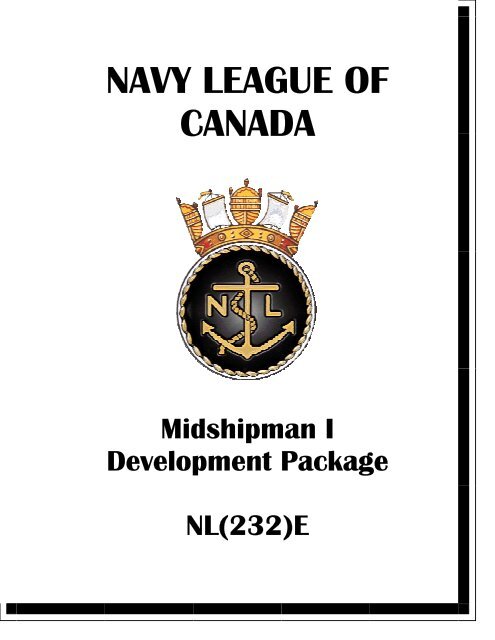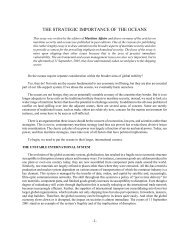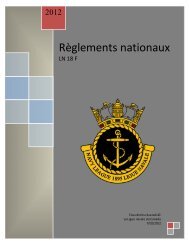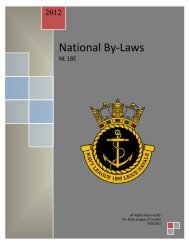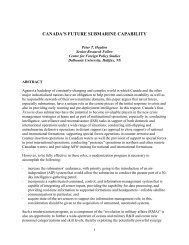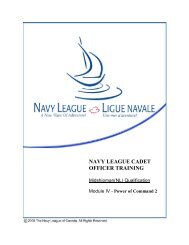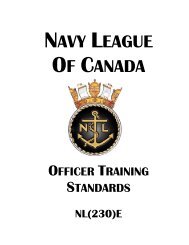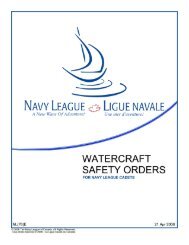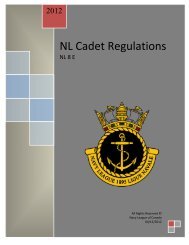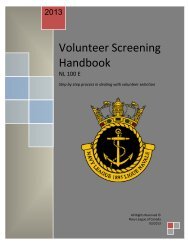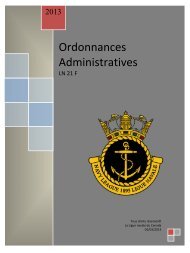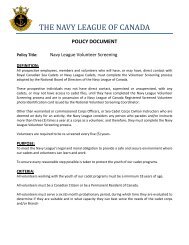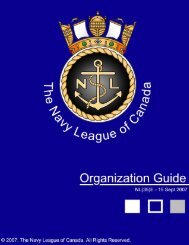NL(232) - The Navy League of Canada
NL(232) - The Navy League of Canada
NL(232) - The Navy League of Canada
You also want an ePaper? Increase the reach of your titles
YUMPU automatically turns print PDFs into web optimized ePapers that Google loves.
.This page left intentionally blank<strong>NL</strong>(<strong>232</strong>)E – 01 Sep 2004 3
Introduction1.01 Historya) Historically, drill was used to manoeuvre field troops across terrain and during battle. Inthe past an army would be measured by the quality <strong>of</strong> the drill, dress, deportment anddiscipline <strong>of</strong> its soldiers. Presently, the Canadian Forces use drill only during ceremonialoccasions (i.e. Remembrance Day parades, Change <strong>of</strong> Command).1.02 Purposea) This chapter provides instructions on procedures for ceremonies involving <strong>Navy</strong> <strong>League</strong>Cadets. It also provides direction and establishes uniformity for drill and ceremonialspecific to <strong>Navy</strong> <strong>League</strong> Cadets. This will allow all <strong>NL</strong> Cadet Corps to perform inaccordance with the customs and finest traditions <strong>of</strong> the <strong>Navy</strong> <strong>League</strong> <strong>of</strong> <strong>Canada</strong>.1.03 Aima) <strong>The</strong> aim <strong>of</strong> drill and ceremonial is to contribute to efficiency and to maintain a highdegree <strong>of</strong> excellence that cadets shall demonstrate during the execution <strong>of</strong> drill andceremonial:i. ensuring that the Cadets efficiently march and manoeuvre together as one; andii.promoting self-discipline, alertness, precision, pride, steadiness and thecohesion necessary for success.1.04 Generala) <strong>The</strong> recruits first observe ship's company organisation and the chain <strong>of</strong> command on theparade square. Here, the <strong>of</strong>ficers, cadet petty <strong>of</strong>ficers and cadets all have their ownduties and functions to perform.1.05 Drill and Procedurea) Drill is composed <strong>of</strong> standard postures, movements and evolutions completed inresponse to particular words <strong>of</strong> command; e.g., "ATTENTION" and "REMOVEHEADDRESS". <strong>The</strong>se commands appear following the heading for each movement inthis manual in quotations. No deviations are allowed unless specifically mentioned in thismanual to ensure that the <strong>Navy</strong> <strong>League</strong> Cadet Organisation marches and manoeuvresas one.b) <strong>The</strong> term “squad” is used as a precursor to each command, and should be called beforethe order during drill lessons and drill practice. When performing drill in ceremonies, thedivision will be given a name to use in replace <strong>of</strong> “Squad” if one has not been designated(i.e. division name).<strong>NL</strong>(<strong>232</strong>)E – 01 Sep 2004 4
1.06 Standard Pausea) <strong>The</strong> standard pause between each drill movement is two beats <strong>of</strong> quick time, i.e., fortymovements to the minute.b) In the early stages <strong>of</strong> training, the division shall call out the time when executing drillmovements.c) To warn the division that the time is to be called out, the instructor will precede thecommand for the movement with the cautionary command CALLING OUT THE TIME.For example, on the command CALLING OUT THE TIME, RIGHT- TURN, the division:i. executes the first movement <strong>of</strong> the turn on the executive order andsimultaneously calls out "One";ii.iii.iv.after completing the first movement, calls "Two", "Three" while observing thestandard pause;when executing the final movement, calls out "One".after completing a movement on the march, a recruit squad shall call the stepfor three paces; e.g., on quick march, "Left- Right -Left".1.07 Drill Standardsa) Exaggerated or modified drill movements and idiosyncrasies demonstrate inefficient andundisciplined training, and a failure <strong>of</strong> the unit to focus on the purpose and use <strong>of</strong> drill inmodern cadet organisations.b) Drill that is well taught and executed develops individual pride, mental alertness,precision and esprit-de-corps which will assist the individual cadet to carry out ordersinstinctively at all times.c) Good drill, well rehearsed, closely supervised and precise, is an exercise in obedienceand alertness. It sets the standard for the execution <strong>of</strong> any duty, both for the individualand the unit, and builds a sense <strong>of</strong> confidence between commander and subordinate thatis essential to high morale.1.08 Particularsa) When the movements calls for either leg to be raised or carried from the deck, the footand lower leg shall remain relaxed, with the toes naturally pointed downwards. <strong>The</strong> footshall be raised so that the toes are 15 cm from the deck.b) When the movement calls for placing the foot on the deck, the individual shall use a “toeheeltouch” in which the toe always makes contact directly before the heel is placed onthe deck.<strong>NL</strong>(<strong>232</strong>)E – 01 Sep 2004 5
2.01 <strong>The</strong> CeremonyCeremonies <strong>of</strong> Colours and Sunseta) What is it, and why do we do it?Historically, the ensign (national flag) was raised to indicate friend or foe to other ships.Today, it is used for ceremonial and traditional purposes.i. <strong>The</strong> Canadian <strong>Navy</strong> performs the ceremony <strong>of</strong> raising the ensign (Colours)every morning at 0800.ii. <strong>The</strong> ceremony <strong>of</strong> lowering the ensign (Sunset) is performed at sunset on ship,and at a preset time when on shore.iii. Personnel required are the same for sunset as it is for colours.b) Personnel for Colours<strong>The</strong> ship’s company (cadet corps) will muster on the drill deck approximately 15 minutesbefore Colours (depends on the corps CO). Cadets are used for the following positions:i. <strong>The</strong> National Flag or Ensign– on the main halyard (usually the centre <strong>of</strong> themast)ii. <strong>The</strong> <strong>Navy</strong> <strong>League</strong> Cadet Flag – on the starboard outer halyard (when facing themast)iii. <strong>The</strong> Preparatory Pennant (Prep)– on the port outer halyard (when facing themast), andiv. Boatswain (Bos’n) – handles the pipes, using a Boatswain’s Call.c) Procedure for Colours<strong>The</strong> cadet on the Ensign announces all reports (below: after the paragraph #s).i. “Five Minutes to Colours, Sir / Ma’am”• Prep closed up (all the way to the top)ii. “One Minute to Colours, Sir / Ma’am”• Parade Commander responds with, “Very Good”• Parade Commander turns Ship’s Company to face the mast (XO, Chief,etc.)iii. “Colours, Sir / Ma’am”• Parade Commander responds with, “Make it so”• Bos’n pipes the still• After the still, members outside <strong>of</strong> a division salute as the Ensign and<strong>NL</strong> Cadet flag are raisediv. “Carry on, Sir / Ma’am”• Parade Commander responds with, “Carry On”• Bos’n pipes the carry on• After the pipe, members saluting come back to attention, cadet strikesthe Prep (all the way down)• Prep is secured.<strong>NL</strong>(<strong>232</strong>)E – 01 Sep 2004 6
d) Procedure for Sunset<strong>The</strong> procedure for sunset is also very similar to that <strong>of</strong> colours, with the followingexceptions:i. In reports from the cadet on the ensign, the word “Colours” is replaced with“Sunset”.ii. <strong>The</strong> ensign and <strong>NL</strong> Cadet flag come down instead <strong>of</strong> up, and they are securedwith the “prep” flag.<strong>NL</strong>(<strong>232</strong>)E – 01 Sep 2004 7
Drill at the Halt3.01 <strong>The</strong> Position <strong>of</strong> Attentiona) purpose – the position <strong>of</strong> readiness. Used when:i. speaking to a superior (i.e. <strong>of</strong>ficer);ii. you are ready to march, and when you stop marching;iii. during inspections; andiv. during Colours and Sunset.b) things to look for:i. heels together and in line;ii. feet turned out to form an angle <strong>of</strong> 30 degrees;iii. body balanced and the weight evenly distributed on both feet;iv. shoulders level and square to the front;v. thumbs touching the seam <strong>of</strong> the pant leg and pointing down, knuckles touchingthe pant leg;vi. arms straight to the side with the elbows and wrists touching the body; andvii. head and eyes straight to the front.(a)(b)(a)(b)Fig. 3-1 Position <strong>of</strong> Attention – (a) view from front; (b) view fromright sideFig. 3-2 Stand at Ease – (a) view from front; (b) position <strong>of</strong>hands from behind<strong>NL</strong>(<strong>232</strong>)E – 01 Sep 2004 8
NOTE: Although this is a still position, do not forget to keep your muscles relaxed and breatheregularly! You may also wiggle your toes and bend your knees SLIGHTLY in order to keepcomfortable. It is also important to be wearing your uniform properly, without being constrictedby a tight belt or small cap.c) You can fall out if you are not feeling well. Take <strong>of</strong>f your cap (hold onto it) and kneeldown. Your DPO (or DO) will see your signal, and walk you <strong>of</strong>f the parade deck to relax.3.02 Attention to Stand at Ease – “Squad, Stand at – EASE”a) purpose – a more comfortable version <strong>of</strong> Attention which should be used when standingstill for longer periods <strong>of</strong> time.b) things to look for:i. raise the left foot 15 cm and move it to the left by bending the left knee, keepingthe foot and lower leg relaxed;ii. straighten the left leg and place the left foot about 25 cm away from the rightfoot (or shoulder width apart);iii. as the left foot touches the deck, both arms are moved behind the back;iv. put the right hand in the palm <strong>of</strong> the left;v. cross thumbs and straighten fingers;vi. balance body evenly on both feet; andvii. the remainder <strong>of</strong> the body is the same as for the position <strong>of</strong> attention.c) <strong>The</strong> timing for this movement is simply, “ONE”, called out as the left foot touches thedeck.3.03 Stand at Ease to Stand Easy – “Squad, Stand – EASY”a) purpose – used when it is time for the division to relax. It is only given if the division isstanding at easeb) things to look for:i. close your hands and bring them to the side as in the position <strong>of</strong> attention;ii. observe a standard pause (1 second); andiii. relax the body - DON’T FALL APART! – no moving your feet or talking.c) <strong>The</strong> timing for this movement is simply, “ONE”, called out as the arms reach the side <strong>of</strong>the body.3.04 Stand at Ease to Attention – “Squad, Atten – TION”a) purpose – used to bring the division to the position <strong>of</strong> Attention and continue with othermovements (i.e. marching, dismissing)b) things to look for:i. carry the left foot to the right by bending the left knee, keeping the foot andlower leg relaxed;<strong>NL</strong>(<strong>232</strong>)E – 01 Sep 2004 9
d) 2 nd Movementi. the right file <strong>of</strong> cadets remains at attention;ii. all others turn their head and eyes to the right as far as possible withoutstraining;iii. at the same time, cadets in the front rank, except the right-hand marker, quicklyextend their right arms to their full extent behind the shoulder <strong>of</strong> the cadet onthe right, arm parallel to the ground;iv. hands are closed as in the position <strong>of</strong> attention;v. back <strong>of</strong> the right hand facing up.e) 3 rd Movementi. the right marker remains at attention;ii. the remainder <strong>of</strong> the division take up correct alignment and distance by takingshort quick paces until in the correct position; andiii. movement starts with the left foot.f) Timing – when all 3 movements are done in sequence, the standard pause is countedbetween each one. <strong>The</strong> timing for this movement is “1…2…3…1…2…3…1”, where thefirst count <strong>of</strong> “1” is when the right foot is placed on the deck, and where the shuffle intoposition occurs immediately after the last count <strong>of</strong> “1”.3.06 Eyes Front – “Squad, Eyes – FRONT”a) purpose – allows the cadets in the division to assume the position <strong>of</strong> attention after aright dress.b) things to look for:i. on the command, cadets will snap their head and eyes to the front and at thesame time, cut the right arm to the side as in the position <strong>of</strong> attention.c) <strong>The</strong> timing for this movement is simply, “ONE”, called out as the right arm is down to theposition <strong>of</strong> attention.3.07 Open Order March – “Squad, Open Order – MARCH”a) purpose – allows more room in between ranks for inspections and rifle drill.b) This order is broken into 4 movements: <strong>The</strong> movements described below are for adivision with three ranks. If the division only has two ranks, the front rank remains at theposition <strong>of</strong> attention.c) 1 st Movementi. cadets in the front rank take one 35 cm pace forward with the left foot;ii. cadets in the rear rank take one 35 cm pace to the rear with the left foot; andiii. keep the remainder <strong>of</strong> the body at the position <strong>of</strong> attention (do not swing arms);and<strong>NL</strong>(<strong>232</strong>)E – 01 Sep 2004 11
“LEFT” “RIGHT” “LEFT” “HALT”Fig. 3-4 Open Order March for the Front Rank - complete movement divided into stages with the timing called for each movement.Notice that the last two images comprise one movement.d) 2 nd and 3 rd Movementsi. cadets in the front rank take 2 more 35 cm paces with the right, and then leftfoot; andii. cadets in the rear rank take 2 more 35 cm paces with the right, and then leftfoot.e) 4 th Movementi. cadets in the front and rear ranks shall bend their right knee and bring their rightfoot beside the left in double time to assume the position <strong>of</strong> attention.f) Timing – When the movements are combined, there is NO standard pause, and thepaces forward and to the rear are performed without stopping. <strong>The</strong> timing for thismovement is “LEFT-RIGHT-LEFT-HALT”.NOTE: It is important for the cadets to practice looking out <strong>of</strong> the corner <strong>of</strong> their eye to maintaindressing while moving in the ranks. Try not to move the head! Usually, a right dress is orderedafter this movement.3.08 Close Order March – “Squad, Close Order – MARCH”a) purpose – used to close up ranks after the Open Order March.b) This order is broken into 4 movements:<strong>NL</strong>(<strong>232</strong>)E – 01 Sep 2004 12
c) 1 st Movementi. cadets in the front rank take one 35 cm pace backward with the left foot;ii. cadets in the rear rank take one 35 cm pace forward with the left foot; andiii. keep the remainder <strong>of</strong> the body at the position <strong>of</strong> attention.d) 2 nd and 3 rd Movementsi. cadets in the front rank take 2 more 35 cm paces back with the right, and thenleft foot; andii. cadets in the rear rank take 2 more 35 cm paces forward with the right, andthen left foot.e) 4 th Movementi. cadets in the front and rear ranks shall bend their right knee and bring their rightfoot beside the left in double time to assume the position <strong>of</strong> attention.f) Timing – When the movements are combined, there is NO standard pause, and thepaces forward and to the rear are performed without stopping. <strong>The</strong> timing for thismovement is “LEFT-RIGHT-LEFT-HALT”.NOTE: It is important for the cadets to practice looking out <strong>of</strong> the corner <strong>of</strong> their eye to maintaindressing while moving in the ranks. Try not to move the head! Usually, a right dress is orderedafter this movement.3.09 <strong>The</strong> Left Turn at the Halt – “Squad, Left – TURN”a) purpose– used to turn a cadet or division 90° to the leftb) This order is broken into 2 movements:c) 1 st Movementii.iii.iv.maintain the position <strong>of</strong> attention with the upper body;keep your arms at your side with both knees braced; andpivot to the left 90° on the left heel and the right toed) 2 nd Movementi. bend your right knee and assume the position <strong>of</strong> attention.e) Timing – when the 2 movements are combined, the timing for the left turn is“1…2…3…1”3.10 <strong>The</strong> Right Turn at the Halt – “Squad, Right – TURN”a) purpose– used to turn a cadet or division 90° to the rightb) This order is broken into 2 movements:<strong>NL</strong>(<strong>232</strong>)E – 01 Sep 2004 13
STANDARDSTANDARDPAUSEPAUSE“ONE” “TWO…THRE “ONE”Fig. 3-5 Left Turn at the Halt - complete movement divided into stages with the timing called for each movement. Notice that the lasttwo images comprise one movement.c) 1 st Movementi. maintain the position <strong>of</strong> attention with the upper body;ii. keep your arms at your side with both knees braced; andiii. pivot to the left 90° on the right heel and the left toed) 2 nd Movementi. bend your left knee and assume the position <strong>of</strong> attention.e) Timing – when the 2 movements are combined, the timing for the right turn is“1…2…3…1”3.11 <strong>The</strong> About Turn at the Halt – “Squad, About – TURN”a) purpose - used to turn a cadet or division 180°, always to the right.b) This order is broken into 2 movements:c) 1 st Movementi. maintain the position <strong>of</strong> attention with the upper body;ii. keep your arms at your side with both knees braced; andiii. pivot to the right 180° on the right heel and the left toe.<strong>NL</strong>(<strong>232</strong>)E – 01 Sep 2004 14
d) 2 nd Movementi. bend your left knee and assume the position <strong>of</strong> attention.e) Timing – when the 2 movements are combined, the timing for the left turn is“1…2…3…1”3.12 Saluting – “Squad, to the front – SALUTE”a) purpose – the movement is used when:i. passing an <strong>of</strong>ficer;ii. before and after speaking with an<strong>of</strong>ficer;iii. when the Canadian Flag is beingraised or lowered (Colours andSunset); andiv. during the playing <strong>of</strong> theNational Anthem.b) This order is broken into 2 movementsc) 1 st Movementi. bend the right elbow and openthe palm <strong>of</strong> the right hand;ii. force the right hand up to theoutside <strong>of</strong> the right eyebrow bythe shortest route (straight up);iii. straighten the thumb and fingers<strong>of</strong> the right hand so that thesecond finger touches the corner<strong>of</strong> the eyebrow;iv. keep the hand, wrist, and forearmin a straight line; andv. keep the upper arm parallel to the deckd) 2 nd Movementi. cut the right arm back down to your side and assume the position <strong>of</strong> attention.e) Timing – when the movements are done in sequence, the standard pause is counted.<strong>The</strong> timing for this movement is “up…2…3…down”.3.13 Remove Headdress – “Squad, Remove – HEADDRESS”Fig. 3-6 To the Front Salutea) purpose – used for prayers and at times when ordered to relax on parade.<strong>NL</strong>(<strong>232</strong>)E – 01 Sep 2004 15
STANDARDPAUSE“UP” “TWO…THREE” “DOWN”(a)(b)Fig. 3-7 Remove HeaddressFig. 3-8 (a) Stand at Ease with Headdress Removed; (b) StandEasy with Headdress Removedb) This order is broken into 2 movements:c) 1 st Movementi. bring the right hand to the peak <strong>of</strong> the cap by the shortest routeii. grasp the front <strong>of</strong> the cap between the thumb and fingeriii. keep fingers aligned and parallel to the shouldersiv. keep upper arm parallel to the deckd) 2 nd Movementi. bring the cap down to the centre <strong>of</strong> the chestii. maintain the grasp on the cap and hold it above the hande) Timing - when the movements are done in sequence, the standard pause is counted.<strong>The</strong> timing for this movement is “up…2…3…down”.NOTES:Standing at Ease with Headdress Removed – same as “Stand at Ease” except that the handsand cap remain in the same position as above;Standing Easy with Headdress removed – cut the right arm (with cap) to the right side <strong>of</strong> thebody, maintaining the same grip and ensuring that the right arm is straight;When at the “Stand Easy” position, cadets should immediately revert to the “Stand at Ease” atthe beginning <strong>of</strong> the next order; and<strong>NL</strong>(<strong>232</strong>)E – 01 Sep 2004 16
Stand at Ease to Attention with headdress removed – same as “Attention” except that the handsand cap remain in the same position.3.14 Replace Headdress – “Squad, Replace – HEADDRESS”a) purpose – used to bring cadets to the proper position <strong>of</strong> attention after headdress hasbeen removedb) This order is broken into 2 movements:c) 1 st Movementi. bring the cap up and place it properly on the head – DO NOT ADJUST IT!;ii. maintain the same grasp on the cap;iii. ensure that hand, wrist, and forearm are in line; andiv. keep forearm parallel to the deck.d) 2 nd Movementi. return the right arm to the position <strong>of</strong> attention by the shortest route.e) Timing – when the movements are done in sequence, the standard pause is countedbetween each one. the timing for this movement is “up…2…3…down”.3.15 <strong>The</strong> Dismissal – “Squad, dis – MISS”a) purpose – to let the cadets in a division carry on in a uniformed mannerb) things to look for:i. the first and second movement make up a right turn at the halt (1…2…3…1);ii. the third movement consists <strong>of</strong> the cadets marching at the quick for 3 paces beforebreaking <strong>of</strong>f at their own time (left…right…left); andiii. if an <strong>of</strong>ficer is on parade or present for a drill class, a “To the front salute” isperformed between the right turn and the marching (standard pause is stillobserved between each movement).c) Timing – when the movements are combined, a standard pause is observed betweeneach one. <strong>The</strong> full timing is as follows;i. no <strong>of</strong>ficer on parade –“1…2…3…1…2…3…left…right…left”ii. <strong>of</strong>ficer on parade –“1…2…3…1…2…3…up…2…3…down…2…3…left…right…left”<strong>NL</strong>(<strong>232</strong>)E – 01 Sep 2004 17
MIDSHIPMAN I DEVELOPMENT PACKAGEOTS 206 CONFIRMATION STAGE #1Select the best response to the following questions and statements. <strong>The</strong> Commanding Officer will signupon proper completion.1. <strong>The</strong> standard pause between each drill movement is ____ beats <strong>of</strong> quick time:a) Oneb) Twoc) Threed) Four2. What drill position do you assume when speaking to a superior?a) Position <strong>of</strong> Stand Easyb) Position <strong>of</strong> Attentionc) Position <strong>of</strong> Stand At Eased) Right Dress3. What is the timing for turns at the halt?___________________4. <strong>The</strong> size <strong>of</strong> the pace for the Open/Close order march is:a) 20 cmb) 25 cmc) 30 cmd) 35 cm5. When the movements calls for either leg to be raised or carried from the deck, the foot andlower leg shall remain relaxed, with the toes naturally pointed downwards. <strong>The</strong> foot shall be6. raised so that the toes are ____ cm from the deck:a) 10 cmb) 15 cmc) 20 cmd) 25 cm7. During the ceremony <strong>of</strong> colours or sunset, the cadet holding the ____ announces all thereports:a) National Flag (ensign)b) <strong>Navy</strong> <strong>League</strong> Cadet Flagc) Preparatory Pennantd) Boatswain CallCO’s Signature:Date:<strong>NL</strong>(<strong>232</strong>)E – 01 Sep 2004 18
MIDSHIPMAN I DEVELOPMENT PACKAGEOTS 206 CONFIRMATION STAGE #2This section provides the Commanding Officer with the opportunity to assess the proper completion <strong>of</strong> theperformance requirements. <strong>The</strong> CO should not sign <strong>of</strong>f each task until it has been completed correctly.<strong>The</strong> following tasks must be completed for the Development Package to be completed.TASK CO’s Signature DateExplains the ceremony <strong>of</strong>Colours/SunsetPosition <strong>of</strong> AttentionPosition <strong>of</strong> Stand At EasePosition <strong>of</strong> Stand EasyRight Dress / Eyes FrontOpen Order MarchClose Order MarchLeft Turn (at the halt)Right Turn (at the halt)About Turn (at the halt)To the front SaluteRemove HeaddressReplace HeaddressDismiss<strong>NL</strong>(<strong>232</strong>)E – 01 Sep 2004 19
OTS 207Uniforms<strong>NL</strong>(<strong>232</strong>)E – 01 Sep 2004 20
<strong>NL</strong>(<strong>232</strong>)E – 01 Sep 2004 21This page left intentionally blank.
INTRODUCTION1.01 APPLICATIONa) Dress Regulations for <strong>Navy</strong> <strong>League</strong> Cadets and Officers, is issued to provide memberswith the policy and instructions for wearing <strong>NL</strong> Cadet and <strong>NL</strong> Officer uniforms.b) To ensure uniformity and the maintenance <strong>of</strong> a high standard <strong>of</strong> dress and deportment,this regulation details policy, authorized items, their method <strong>of</strong> wear and standards <strong>of</strong>personal appearance.1.02 AUTHORITY AND STANDARDSa) Dress Regulations for <strong>Navy</strong> <strong>League</strong> Cadets and Officers shall be interpreted as follows:If an item is not included in these regulations, it is not authorized.b) All cadets parading as a group in uniform shall be required to wear the same order <strong>of</strong>dress, except wear specifically exempted (i.e. type <strong>of</strong> footwear). <strong>The</strong> same applies to<strong>Navy</strong> <strong>League</strong> Officers.c) <strong>The</strong> right to wear a <strong>Navy</strong> <strong>League</strong> Officer Uniform is granted solely by the National <strong>Navy</strong><strong>League</strong> Cadet Committee. Even if an individual purchases uniforms, they may only beworn by authorized (warranted) individuals.1.03 CONDUCT WHILE IN UNIFORM (<strong>NL</strong> 8)a) <strong>The</strong> uniform worn by <strong>Navy</strong> <strong>League</strong> Cadet Officers and Cadets is naval in character andhas a historic origin. It is to be worn with care and pride, and protected from all abuseand misuse by those granted permission to wear it.b) <strong>Navy</strong> <strong>League</strong> Officers and Cadets are to conduct themselves in a manner that bringscredit to their Corps and <strong>The</strong> <strong>Navy</strong> <strong>League</strong> <strong>of</strong> <strong>Canada</strong> at all times while they are in <strong>Navy</strong><strong>League</strong> uniform.1.04 OCCASIONS WHEN UNIFORM WORN (<strong>NL</strong> 8)a) <strong>Navy</strong> <strong>League</strong> uniforms shall be worn:i. To, from, and at regular drills, parades or meetings;ii.iii.At other <strong>of</strong>ficial ceremonies and parades; and,As ordered by the Commanding Officer.b) Uniforms are not to be worn during any work, sport or other activity likely to dirty ordamage them.<strong>NL</strong>(<strong>232</strong>)E – 01 Sep 2004 22
OFFICER UNIFORMS2.01 GENERALa) Officers shall wear the <strong>Navy</strong> <strong>League</strong> uniform authorized by National Board <strong>of</strong> Directors.No items other than those described in this section are considered part <strong>of</strong> the uniform.2.02 SUPPLY OF UNIFORMa) <strong>The</strong> <strong>Navy</strong> <strong>League</strong> Branch is to provide the basic uniform on loan to all Officers. It is tobe returned to the Corps when the <strong>of</strong>ficer leaves the Corps.b) Most parts are purchased from the National Distributor.c) <strong>Navy</strong> <strong>League</strong> Officers are not entitled to Canadian Forces uniforms, and arenot to acquire any uniform items from any Canadian Forces source <strong>of</strong> supplyby any means! To do so may be considered an act <strong>of</strong> fraud by theGovernment <strong>of</strong> <strong>Canada</strong>.2.03 MALE NAVY LEAGUE CADET OFFICER SERVICE DRESSa) Male Officers shall wear uniforms, as authorized in <strong>NL</strong> 8, Article 4.11, consisting <strong>of</strong>:i. Cap - Naval pattern, white, with plain black peak. An appropriate turban may beworn with the C.O.'s permission. Commanders (<strong>NL</strong>) shall wear a naval pattern,white, with Oak Leaf cluster on peak.ii.iii.iv.Cap Badge - <strong>Navy</strong> <strong>League</strong> pattern.Jacket - <strong>Navy</strong> blue, double breasted, with six <strong>Navy</strong> <strong>League</strong> pattern buttons.Insignia - Shoulder Flashes - <strong>Navy</strong> <strong>League</strong> pattern "<strong>Navy</strong> <strong>League</strong> <strong>Canada</strong>" on bothsleeves, centred 1/4 inch below the shoulder seams.v. Rank - <strong>Navy</strong> <strong>League</strong> pattern gold lace (full width 1/2 inch, half width 1/4 inch) (seeAnnex A) with <strong>Navy</strong> <strong>League</strong> pattern maple leaf cloth badge 1/4 inch above theuppermost row <strong>of</strong> lace on both sleeves, or four inches above the cuff forMidshipmen(<strong>NL</strong>).vi.vii.viii.ix.Trousers - <strong>Navy</strong> blue, <strong>of</strong> the same material and colour as jacket.Shirt - White long sleeved dress shirt with turn down collar.Tie - Plain black.Shoes - Black oxford style (with laces) and plain toe.x. Socks - Plain black.<strong>NL</strong>(<strong>232</strong>)E – 01 Sep 2004 23
Optional Wear – the following items may be worn as dictated by the time <strong>of</strong> year:i. Summer - A short sleeved white military style shirt with gold on white "<strong>Navy</strong><strong>League</strong> <strong>Canada</strong>" shoulder flashes (available through Alberta Division) andepaulettes with slip-on rank insignia, or appropriate shoulder boards, may be wornwith the top button undone, without jacket or tie, with the uniform navy bluetrousers. Name tags are to be worn above the right pocket, and medal ribbonsabove the left pocket. This optional summer dress should not be worn onceremonial occasions.ii.Winter - A naval pattern double breasted overcoat with <strong>Navy</strong> <strong>League</strong> brassbuttons, shoulder boards, or a naval style burberry. When gloves are worn theyare to be black leather.2.04 FEMALE NAVY LEAGUE CADET OFFICERS SERVICE DRESSa) Female <strong>of</strong>ficers shall wear uniforms, as authorized in <strong>NL</strong> 8, Article 4.11, consisting <strong>of</strong>:i. Cap - Naval pattern tricorn, or Naval pattern female, white, with plain black peak.ii.iii.iv.Cap Badge - <strong>Navy</strong> <strong>League</strong> pattern.Jacket - <strong>Navy</strong> blue, single breasted, with four <strong>Navy</strong> <strong>League</strong> pattern buttons.Insignia - Shoulder Flashes - <strong>Navy</strong> <strong>League</strong> pattern "<strong>Navy</strong> <strong>League</strong> <strong>Canada</strong>" on bothsleeves, centred 1/4 inch below the shoulder seams.v. Rank - <strong>Navy</strong> <strong>League</strong> pattern gold lace (full width 1/2 inch, half width 1/4 inch) with<strong>Navy</strong> <strong>League</strong> pattern maple leaf cloth badge 1/4 inch above the uppermost row <strong>of</strong>lace on both sleeves, or four inches above the cuff for Midshipmen(<strong>NL</strong>).vi.vii.viii.ix.Skirt - <strong>Navy</strong> blue - "A-line" pattern, <strong>of</strong> same material and colour as jacket.Shirt - White long sleeved dress shirt with turned down collar.Tie - Plain black.Shoes - Black oxford style with plain toe.x. Stockings - With skirts, black or beige, consistent within a Corps; with trousers,black stockings or socks.Optional Wear – the following items may be worn by female <strong>of</strong>ficers:i. Trousers - Trousers may be worn in lieu <strong>of</strong> a skirt provided they are <strong>of</strong> the samematerial and colour as the jacket. Black stockings or socks are to be worn withtrousers.<strong>NL</strong>(<strong>232</strong>)E – 01 Sep 2004 24
ii.iii.Summer - A short sleeved white military style shirt with gold on white "<strong>Navy</strong><strong>League</strong> <strong>Canada</strong>" shoulder flashes (available through Alberta Division) andepaulettes with slip-on rank insignia, or appropriate shoulder boards, may be wornwith the top button undone, without jacket or tie, with the uniform navy bluetrousers. Name tags are to be worn above the right pocket, and medal ribbonsabove the left pocket. This optional summer dress should not be worn onceremonial occasions.Winter - A naval pattern double breasted overcoat with <strong>Navy</strong> <strong>League</strong> brassbuttons, shoulder boards, or a naval style burberry. When gloves are worn theyare to be black leather.2.05 WORK DRESSb) Male or female <strong>of</strong>ficers may wear work dress when their dress uniform would not beappropriate or would be subject to soiling or damage. Work dress shall not be worn onformal parades or other ceremonial occasions. <strong>The</strong> approved work dress consists <strong>of</strong>:i. Cap - Dress uniform cap or navy blue beret.ii.iii.iv.Cap Badge - <strong>Navy</strong> <strong>League</strong> pattern (small size for beret).Jacket - Lined navy blue windbreaker style jacket with a zipper closure, breastpockets, slant side pockets and epaulettes.Insignia - Shoulder Flashes - <strong>Navy</strong> <strong>League</strong> pattern "<strong>Navy</strong> <strong>League</strong> <strong>Canada</strong>" onboth jacket sleeves, centred 1/4 inch below the shoulder seams.v. Rank - Slip-on rank insignia will be worn on the jacket, or on the shirt when ajacket is not being worn.vi.vii.viii.ix.Trousers - <strong>Navy</strong> blue, <strong>of</strong> the same material and colour as jacket.Shirt - Dark blue or white, military style with epaulettes.Tie - Plain black (optional).Shoes - Black oxford style; black military style boots; or, if working around boats,clean white running shoes.x. Socks - Black with shoes or grey with boots or running shoes.xi.Sweaters - <strong>Navy</strong> blue, ribbed knit sweaters with crew or vee neck, cloth elbow andshoulder patches, and epaulettes may be worn with the dress uniform or workdress in lieu <strong>of</strong> a jacket. Sweaters are not to be worn on parades or ceremonialoccasions.<strong>NL</strong>(<strong>232</strong>)E – 01 Sep 2004 25
2.06 FORMAL DRESSa) Formal uniform may be worn at appropriate functions, such as military mess dinners,other formal dinners, dances, etc.b) <strong>The</strong> authorized formal uniform for <strong>Navy</strong> <strong>League</strong> Cadet Officers is the regular dressuniform with a black bow tie. Female <strong>of</strong>ficers may wear a black cross-over tie. If medalsare worn they must be full size.c) Officers are no longer permitted to wear ‘mess dress’ (since December 1998). <strong>The</strong> onlyauthorized formal attire is as outlined in subpara (b).2.07 MEDALS / RIBBONSa) Officers may only wear authorized Canadian Orders, Decorations or Medals with <strong>Navy</strong><strong>League</strong> uniforms in the approved manner. Medals are to be worn on all formaloccasions, and the appropriate ribbons are to be worn on informal occasions.b) An Officer who was awarded an Order, Decoration or Medal by a foreign power may begranted approval to wear the insignia and/or ribbon while in <strong>Navy</strong> <strong>League</strong> uniform. Toobtain approval the Officer must submit a written request with documentation <strong>of</strong> theaward through his C.O., Branch and Division to the National Office for approval by theNational <strong>Navy</strong> <strong>League</strong> Cadet Committee.c) Officers are not to wear <strong>NL</strong> medals or ribbons which they received as Cadets.d) All authorized medals are to be worn on the left side <strong>of</strong> the jacket centred above thebreast pocket, with the following exceptions:i. <strong>The</strong> Long Service Medal is to be worn on the right side <strong>of</strong> the jacket, 2mm belowand centred with the nametag, or, in place <strong>of</strong> the medal, the service pin (see article3.07): andii.<strong>The</strong> Duke <strong>of</strong> Edinburgh pin shall be on the right side <strong>of</strong> the jacket, 2mm above andcentred with the nametag.2.08 NAME TAG / SERVICE PINa) Officers are to wear 3" x 1/2", surname only, white lettering on black background nametags on the right breast <strong>of</strong> their uniforms opposite the top <strong>of</strong> the breast pocket.b) Officers may wear coloured pins indicating years <strong>of</strong> <strong>Navy</strong> <strong>League</strong> service (by colour) ontheir uniforms. <strong>The</strong>se pins (available from Ontario Division) are to be worn on the rightbreast below the nametag.2.09 CANADIAN FORCES SPECIALIST INSIGNIAa) An Officer may wear specialist insignia which he has previously earned and worn whilean <strong>of</strong>ficer or member <strong>of</strong> the Canadian Forces. <strong>The</strong> insignia is to be worn one inch abovethe Maple Leaf on the left sleeve.<strong>NL</strong>(<strong>232</strong>)E – 01 Sep 2004 26
2.10 OFFICER'S SWORDa) Corps C.O.'s and Guard Officers may wear Naval swords on ceremonial occasions.Female Officers wearing swords are to wear trousers.2.11 HAIRa) Males - Hair shall be:i. Neatly groomed;ii.iii.iv.Taper-trimmed at the back, sides, and above the ears to blend with the hair style;No more than 15 cm in length, and sufficiently short so that when the hair isgroomed and head-dress is removed, no hair shall touch the ears, or fall belowthe top <strong>of</strong> the eyebrows;Styled so that it does not present a bizarre or exaggerated appearance, orinterfere with the proper wearing <strong>of</strong> any head-dress; andv. Kept free from the neck to a distance <strong>of</strong> 2.5 cm above the shirt collar.vi.Aboriginal – Long hair that does not extend below the lower edge <strong>of</strong> the shirtcollar shall be styled neatly. Long hair that does extend below the lower edge <strong>of</strong>the shirt collar shall be gathered behind the head with a small-unadorned fastener<strong>of</strong> a colour that blends with that <strong>of</strong> the hair itself, or the hair shall be braided.Single and double braids shall be styled conservatively and tied tightly, secured atthe end by a knot or a small-unadorned fastener as above. <strong>The</strong> maximum length<strong>of</strong> hair shall not extend below the top <strong>of</strong> the armpit. If hair normally extends belowthis, it will be tied up in order to conform to the above stated styles <strong>of</strong> hair. It doesnot need to be cut.b) Femalesi. Hair shall be kept neatly groomed and shall not extend below the lower edge <strong>of</strong> theshirt collar. Varying hairstyles, straight or curled, are permitted within these limits,but bizarre or unusual hair colours are not authorized. In no case shall the bulk orlength <strong>of</strong> the hair detract from a positive appearance or preclude the wearing <strong>of</strong>uniform headdress.ii.iii.Hair ornaments shall not be worn. Every effort shall be made to ensure that bobbypins, hairpins and similar items used to secure hair as unobtrusive as possible.Braids – Shall be styled conservatively and tied tightly, secured at the end by aknot or a small-unadorned fastener. A single braid shall be worn in the centre <strong>of</strong>the back. Double braids shall be worn behind the shoulders. Hair shall not extendbelow the top <strong>of</strong> the armpit when gathered behind the head or braided.<strong>NL</strong>(<strong>232</strong>)E – 01 Sep 2004 27
2.12 JEWELLERYa) Female Officers may wear plain gold or silver studs or sleepers in their ears. Under nocircumstances are male Officers or Cadets to wear earrings <strong>of</strong> any kind while they are inuniform.b) <strong>The</strong> only other jewellery that may be worn in uniform shall be a wristwatch, a medicalalert chain identifier, a maximum <strong>of</strong> two rings, and a tie clasp. Additional rings may beworn where they indicate pr<strong>of</strong>essional standing, such as an engineer, or are worn with awedding band as a single set indicating betrothal or fidelity, such as an engagement oranniversary ring.c) Body tattoos and body piercing - Members shall not acquire visible tattoos that could bedeemed to be <strong>of</strong>fensive (e.g. pornographic, blasphemous, racist) or otherwise reflectdiscredit on the <strong>NL</strong>OC. Members either in uniform or on duty in civilian clothing shall notwear visible and non-visible body piercing adornments, with the exception <strong>of</strong> women’searrings and ear sleepers.<strong>NL</strong>(<strong>232</strong>)E – 01 Sep 2004 28
MAINTENANCE3.01 GENERALa) Officers shall maintain their uniforms to the highest standard. <strong>The</strong> cadets will consideryour uniform as a standard. If you have boots/shoes that have a high gloss, the cadetswill likely want to achieve the same.CAP -Notes:Male caps: On the white part, your cap should be cleaned with a s<strong>of</strong>t brush,warm or hot water, and mild detergent such as dish soap. <strong>The</strong> beak andchinstay can be buffed with a Kiwi cloth.Female caps: : <strong>The</strong> white part is made <strong>of</strong> leather. Your cap should becleaned with a cloth (use a s<strong>of</strong>t brush for stubborn markings), warm or hotwater, use a mild detergent such as dish soap.Both caps: Take care not to allow any soap to reach the black material.After your cap is clean it should be wiped dry (important for the female cap,as it can warp), placed in a bag and stored where it won't get crushed.a. Most clothing can be machine washed / dried, but do read the manufacturer’scleaning instructions on the label.b. Jacket and Trousers: It is recommended that these are dry cleaned.c. Workdress clothing doesn’t normally require ironing. It must be clean andpresentable. .TROUSERS -SHIRT -BOOTS -Press with a damp lint-free cloth. Press a crease down the front and back<strong>of</strong> your trousers in the centre. Try to press as high as you can go withoutincluding additional (and incorrect) creases. When finished place them on apant hanger or a hanger that will not leave a crease through the middle.If you iron your shirt on a high temperature it will come out nicely.Press your collar, epaulettes, and cuffs first.For the sleeves, place them on the ironing board with the seam to one side.Iron each sleeve flat. On the long sleeve white shirt, ensure the creaseruns the length <strong>of</strong> the sleeve from the centre <strong>of</strong> the epaulette straightdown to the top <strong>of</strong> the cuff. On the short sleeve white shirt, ensure thecrease only runs from the bottom <strong>of</strong> the shoulder flash to the bottom end<strong>of</strong> the sleeve. DO NOT crease the badge, nor above it.Make sure no threads (Irish pennants) are sticking out. If so, clip them <strong>of</strong>fwith a pair <strong>of</strong> scissors.Place a LIGHT coat <strong>of</strong> black shoe polish (Kiwi works best) on the boots let itdry for 15 to 20 minutes, then using cold-water rub in small circles until ashine can be seen. When finished the boots can be buffed with an old nylon.Do not use a shoe brush, it works fine for normal shoes, however, it is nextto impossible to get a high gloss shine using a brush. Your boots should bepolished after every time you wear them. When finished put them in a placewhere they will not get scuffed.<strong>NL</strong>(<strong>232</strong>)E – 01 Sep 2004 29
MIDSHIPMAN I DEVELOPMENT PACKAGEOTS 207 CONFIRMATION STAGE #1Select the best response to the following questions and statements. <strong>The</strong> Commanding Officer will signupon proper completion.1. <strong>Navy</strong> <strong>League</strong> uniforms shall be worn:a) To, from, and at regular drills, parades or meetings,b) At other <strong>of</strong>ficial ceremonies and parades,c) As ordered by the Commanding Officer,d) All <strong>of</strong> the above2. <strong>Navy</strong> <strong>League</strong> <strong>of</strong>ficer uniforms shall only be worn by warranted individuals.TrueFalse3. While in uniform, female <strong>of</strong>ficers can wear ___________ or _____________ in their ears.4. Which <strong>of</strong> the following is acceptable jewellery that may be worn in uniform?a) Beadsb) Pendantc) Wristwatchd) Bracelet5. Regarding the rules for hair, which <strong>of</strong> the following is statements are false?a) Both genders: Hair shall be kept neatly groomed.b) Male: hair can be short enough to touch the ears, and fall below the top <strong>of</strong> theeyebrows.c) Female: Hair ornaments shall not be worn.d) Both genders: Hair shall not detract from a positive appearance or preclude thewearing <strong>of</strong> uniform headdress.6. <strong>The</strong> uniform with a dark blue workshirt, navy blue trousers, and a navy blue beret is calledthe: __________________________.7. Which <strong>of</strong> the following is not an authorized optional item?a) Short sleeved white military style shirt,b) Naval style double breasted overcoat,c) Black leather gloves,d) None <strong>of</strong> the aboveCO’s Signature:Date:<strong>NL</strong>(<strong>232</strong>)E – 01 Sep 2004 30
MIDSHIPMAN I DEVELOPMENT PACKAGEOTS 207 CONFIRMATION STAGE #2This section provides the Commanding Officer with the opportunity to assess the proper completion <strong>of</strong> theperformance requirements. <strong>The</strong> CO should not sign <strong>of</strong>f each task until it has been completed correctly.<strong>The</strong> candidate may seek guidance from an experienced <strong>of</strong>ficer if required.<strong>The</strong> following tasks must be completed for the Development Package to be completed.Demonstrate uniformmaintenanceTASK CO’s Signature DateCapJacket/TunicShirtTrousers/SkirtWear the correct uniformIAW Routine OrdersSets a good exampleShoesDemonstrates good conductwhile in uniform<strong>NL</strong>(<strong>232</strong>)E – 01 Sep 2004 31
OTS 208Divisional System<strong>NL</strong>(<strong>232</strong>)E – 01 Sep 2004 32
<strong>NL</strong>(<strong>232</strong>)E – 01 Sep 2004 33This page left intentionally blank.
1.01 HISTORY<strong>The</strong> Divisional System came about over 200 years ago out <strong>of</strong> necessity. At the time, sailors dealtwith the following conditions:• low pay• poor living conditions and food• long and difficult working conditionsOnce the Divisional System was in place, concern for the sailors living and working conditionsbecame the primary concern <strong>of</strong> the <strong>of</strong>ficers in charge.This created a better working atmosphere and helped promote TEAMWORK!!! .Today, every navy in the world runs based on the Divisional System (including <strong>Navy</strong> <strong>League</strong> andSea Cadets).1.02 HOW DOES IT WORK?Called the Divisional System because everything is broken into “divisions”:• division <strong>of</strong> groups <strong>of</strong> sailors• division <strong>of</strong> responsibility and workThis makes it easier to take care <strong>of</strong> the needs <strong>of</strong> each individual sailor.• In <strong>Navy</strong> <strong>League</strong> Cadets, divisions normally consist <strong>of</strong> 1 <strong>of</strong>ficer and a group <strong>of</strong> cadets (numbersdepend on corps strength). Larger corps may split up their cadets into divisions based on thefunctions at the corps (Band, guard, etc…).Division names may be applied to further distinguish the groups as well as providing some “espritde corps” for the cadets. Divisions are normally named after a particular class <strong>of</strong> naval ships (ie.Halifax Class Frigates) or the phonetic alphabet.(refer to the diagram on the next page as you read the next four paragraphs)• If a cadet has a question or concern, they will normally go to the Divisional Petty Officer (DPO)or Chief. <strong>The</strong> DPO will then go to the Divisional Officer (DO). At times, the cadet will godirectly to the DO, which is understandable since the DPO is <strong>of</strong>ten a child, like the cadet.• If the DO is unable to answer the question or solve the problem, they will proceed to theExecutive Officer (XO) who is responsible for all Divisions.• If necessary, the XO will approach the Commanding Officer (CO).• <strong>The</strong> response should come back down divisional system in the same manner as it went up. Ifthe cadet asks the DO a question, the DO should deliver the answer.<strong>NL</strong>(<strong>232</strong>)E – 01 Sep 2004 34
COXODODPOCADET1.03 DIVISIONAL OFFICERS<strong>The</strong> Divisional Officer is the most important job. <strong>The</strong> DO will care for and promote the welfare <strong>of</strong>cadets in their charge.Within the normal divisional system, all matters must always start with the DPO. However, whendealing with cadets, the DO must always have their ear to the ground. <strong>The</strong>re is nothing wrong withallowing your DPO to handle questions <strong>of</strong> a routine nature, but when necessary (conflict resolution,personal matters, etc.), the DO must intervene. <strong>The</strong> DPO must also know when to pass problemsto the DO, which enforces the necessity for a strong relationship <strong>of</strong> the divisional staff.• <strong>The</strong> DO has the responsibility <strong>of</strong> determining the best action to take in any given situation. Anyproblem <strong>of</strong> a personal or behavioural matter will most <strong>of</strong>ten move up the Divisional System tothe XO. Any other matter, if not handled by the DO, will be directed to the appropriate <strong>of</strong>ficer inthe Chain <strong>of</strong> Command.For Example:A question about missing a week <strong>of</strong> training – Training OfficerA problem with a uniform item – Supply Officer• <strong>The</strong> problems or requests that may be brought to the DO are many and varied. It may be asimple request for leave, a personal problem, a service matter concerning rank, etc. If they sodesire, every member is entitled to meet with their commanding <strong>of</strong>ficer, provided they gothrough the proper channels.• <strong>The</strong>re is no better way to assist in morale than by the DPO and DO taking a personal interest ineach cadet. <strong>The</strong>re is no excuse for the DPO and DO not knowing the name <strong>of</strong> each cadet intheir division. Whenever possible, the DPO/DO should be aware <strong>of</strong> a cadet’s personal situationand circumstances (strengths, weaknesses, hobbies, physical disabilities, impairments,brothers and sisters, school situation, etc).<strong>NL</strong>(<strong>232</strong>)E – 01 Sep 2004 35
• As a divisional <strong>of</strong>ficer it is imperative that you maintain a written record <strong>of</strong> the cadets inyour division. This record should contain the personal information as to the parent’snames, address, school, grade, teacher, etc. For example, a child with asthma shouldalways carry an inhaler with them, and the DO can do routine checks.• This record should also list the all the <strong>Navy</strong> <strong>League</strong> activities attended and should have amonthly entry on the cadet’s performance, including dress and deportment, attendance, cooperation,extra activities, tag days, etc. This record becomes an invaluable tool when decidingwho should receive trophies and awards. A good Divisional Officer’s notebook will giveirrefutable pro<strong>of</strong> that a particular cadet deserves and has earned what they are nominated for.1.04 CHAIN OF COMMAND<strong>The</strong> Chain-<strong>of</strong>-Command is simply the best way <strong>of</strong> organizing people so that orders and informationget passed down from one person to the next.• <strong>The</strong> Chain-<strong>of</strong>-Command differs from the Divisional System in the fact that it forms the structure<strong>of</strong> the unit based on positions within the corps.• Whereas the Divisional System was designed to assist individuals and their workingenvironment, the Chain <strong>of</strong> Command is a tool used for the good <strong>of</strong> the unit. It is used to passinformation as easily as possible up and down the corps hierarchy.COXOChiefTRGOADMOSUPODODODOInstructorsDPODPODPO<strong>NL</strong>(<strong>232</strong>)E – 01 Sep 2004 36
MIDSHIPMAN I DEVELOPMENT PACKAGEOTS 208 CONFIRMATION STAGE #1Select the best response to the following questions and statements. <strong>The</strong> Commanding Officer will sign uponproper completion.1. Normally, a cadet with a question or concern will approach their DPO. Sometimes the cadetwill go directly to the DO, which is sometimes understandable. Who is the next step in theDivisional system?a) COb) XOc) TRGOd) None <strong>of</strong> the above2. If a cadet asks the DO a question, the ____ should deliver the answer.a) COb) XOc) DOd) DPO3. How many divisions are in your Corps?______4. Fill in the information about the divisions in your Corps?Division Name: Divisional Officer: Divisional Petty Officer:CO’s Signature:Date:<strong>NL</strong>(<strong>232</strong>)E – 01 Sep 2004 37
MIDSHIPMAN I DEVELOPMENT PACKAGEOTS 208 CONFIRMATION STAGE #2Finish the organizational chart to represent your own Corps Chain <strong>of</strong> Command. <strong>The</strong> Commanding Officerwill sign upon proper completion.(the first box is drawn for you)COCO’s Signature:Date:<strong>NL</strong>(<strong>232</strong>)E – 01 Sep 2004 38
OTS 209<strong>Navy</strong> <strong>League</strong> CadetTraining Program<strong>NL</strong>(<strong>232</strong>)E – 01 Sep 2004 39
<strong>NL</strong>(<strong>232</strong>)E – 01 Sep 2004 40This page left intentionally blank.
1.01 DEVELOPMENT OF THE NAVY LEAGUE CADET TRAINING PROGRAM<strong>The</strong> <strong>Navy</strong> <strong>League</strong> Cadet Program is committed to developing <strong>Canada</strong>’s youth through moralguidance and encouragement, as well as mental and physical training designed to developpatriotism, good citizenship, a sense <strong>of</strong> duty, self-discipline, self-respect and respect for others, in amodern nautical environment built on sound naval traditions.To ensure the training program fulfills these objectives, a ‘value-based’training model is used. <strong>The</strong> ‘value-based’ model links each Element <strong>of</strong> theprogram (such as Respect for Others) with specific Values to be instilled ineach cadet (such as Generosity). Each value is developed and supportedthough the acquisition <strong>of</strong> Knowledge and the application <strong>of</strong> learningthrough focused Activities.This approach to training program development was adopted by theNational <strong>Navy</strong> <strong>League</strong> Cadet Committee in 1998, following the publication<strong>of</strong> the “Bastille Paper”. This document, produced by Vancouver IslandDivision, detailed the requirement for a critical review <strong>of</strong> the trainingprogram to ensure that the curriculum was relevant and supported the aims<strong>of</strong> the program.A copy <strong>of</strong> the ‘Bastille Matrix’ is included on the following page for yourreference.This matrix is a valuable tool that you can use when developing corpstraining and activities as this process will ensure your corps’ activitiessupport the aims <strong>of</strong> the program.ElementsValuesKnowledge<strong>The</strong> development <strong>of</strong> the <strong>Navy</strong> <strong>League</strong> Cadet program has become acontinual process. By examining activities within the value basedframework it is easy to determine if an activity is still relevant or if it needsto be adapted to meet changing conditions. This allows the program to be ‘evergreen’.ActivitiesAs a <strong>Navy</strong> <strong>League</strong> Officer you can help this process by contributing your ideas for lesson plans,training aids and activities. <strong>The</strong> sharing <strong>of</strong> Best Practices enriches the program and makes theimportant job <strong>of</strong> training your cadets more effective and much easier.Send your training ideas to: navyleaguecadets@navyleague.ca.<strong>NL</strong>(<strong>232</strong>)E – 01 Sep 2004 41
Bastille MatrixELEMENTS VALUES KNOWLEDGE ACTIVITIESI. BELONGINGto<strong>Canada</strong>Our Community<strong>Navy</strong> <strong>League</strong>PridePatriotismCommitmentResponsibilityLoyaltySense <strong>of</strong> dutyValue <strong>of</strong> CitizenshipRights and Duties <strong>of</strong> citizensOur Country, our province<strong>Navy</strong> <strong>League</strong> HistoryCorps HistoryCorps OrganizationRegular AttendanceResearch projectsLecturesCommemoration paradesVisits to -Citizenship Court-Historic Sites-Legislature/Municipal HallInvolvement in Community projectsFund raisingII. SELF- RESPECTANDSELF-IMPROVEMENTTruthfulnessSelf-DisciplineSelf-RespectGood AppearanceGood ConductPhysical and mental FitnessLeadership<strong>NL</strong> UniformPersonal Safety ProgramsProper wearing <strong>of</strong> uniformDrill and Parade TrainingSportsAdventure Training and OrienteeringMulti-corps eventsCamping tripsIII. RESPECTFOROTHERSGenerosityRespect for superiors andeldersGood FellowshipGood MannersCommunity programsFirst Aid TrainingTeam gamesSportsCommemoration paradesParticipation in Community projectsMulti-corps events, etc.IV. KNOWLEDGEOFTHE SEAInitiativeSelf RelianceLeadership<strong>The</strong> Sea and the OceansBoatwise ProgramNaval HistoryNaval environmentSeamanshipResearch projectsShips VisitsSailingTrips at seaSeamanship Training<strong>NL</strong>(<strong>232</strong>)E – 01 Sep 2004 42
1.02 OBJECTIVES<strong>The</strong> following objectives are based on the values supported by the <strong>Navy</strong> <strong>League</strong> Movement. <strong>The</strong>aim <strong>of</strong> the program is to help 9 – 12 year-old <strong>NL</strong> Cadets acquire new skills and develop characterand self-confidence.a) To develop in <strong>NL</strong> Cadets a sense <strong>of</strong> loyalty and commitment to <strong>Canada</strong> and to theircommunityb) To develop in <strong>NL</strong> Cadets a sense <strong>of</strong> commitment to their Corps and <strong>of</strong> loyalty and respectfor their <strong>of</strong>ficers and instructorsc) To help <strong>NL</strong> Cadets learn self-discipline and self-respectd) To help <strong>NL</strong> Cadets develop good physical and mental fitnesse) To instil in <strong>NL</strong> Cadets a sense <strong>of</strong> initiative and self-reliancef) To develop teamwork among cadets and encourage them to help othersg) To encourage <strong>NL</strong> Cadets to learn about the sea and shipsh) To give <strong>NL</strong> Cadets first aid trainingi) To create a healthy environment where <strong>NL</strong> cadets can have funj) To inform <strong>NL</strong> Cadets about the Cadet movement1.03 GENERAL<strong>The</strong> <strong>Navy</strong> <strong>League</strong> program consists <strong>of</strong> three consecutive years <strong>of</strong> training. One year <strong>of</strong> training isequal to 30 weeks <strong>of</strong> training. <strong>The</strong> training is broken into 5 levels as follows:Level 1 – 15 weeksLevel 2 – 15 weeks1 st yearLevel 3 – 15 weeksLevel 4 – 15 weeksLevel 5 – 30 weeks2 nd year3 rd year1.04 CADET TRAINING STANDARD (CTS)<strong>The</strong>re are 13 training subjects presented to cadets during their 3 years in <strong>NL</strong> Cadets. Cadets do notget exposure to all subjects each year, while others are present in all 3 years. Subject exposure isbased on the age and experience <strong>of</strong> cadets, and the level <strong>of</strong> topic comprehension.a) CTS 01 Corps Organization and Ship’s Routine<strong>The</strong> aim <strong>of</strong> this subject is to familiarize new cadets with basic organizational knowledge inorder to ease them into the system.lessons: ranks, divisional system, duties and privileges, etc.<strong>NL</strong>(<strong>232</strong>)E – 01 Sep 2004 43
) CTS 02 Wearing and Maintenance <strong>of</strong> Uniform<strong>The</strong> aim <strong>of</strong> this subject is to teach cadets the proper method <strong>of</strong> wearing and maintaining theuniform.lessons: uniform parts and maintenancec) CTS 03 <strong>Navy</strong> <strong>League</strong> Movement<strong>The</strong> aim <strong>of</strong> this subject is to inform cadets <strong>of</strong> the history and objectives <strong>of</strong> the <strong>Navy</strong> <strong>League</strong>.d) CTS 04 Drill<strong>The</strong> aim <strong>of</strong> this subject is for the cadets to learn the minimum number <strong>of</strong> movements toperform in a parade with a march past.lessons: basic drill at the halt, drill on the march, drill command, etc.e) CTS 05 Canadian Citizenship<strong>The</strong> aim <strong>of</strong> this subject is to instill national, community, and corps pride in the cadets, and toallow them the opportunity to perform volunteer acts within the community.lessons: Canadian heritage, social Issues, community involvementf) CTS 06 Seamanship<strong>The</strong> aim <strong>of</strong> this subject is to teach cadets the seamanship skills necessary for sailing, and tointroduce them to fancy Ropework.lessons: knots and hitches, fancy ropework, etc.g) CTS 07 Naval Knowledge<strong>The</strong> aim <strong>of</strong> this subject is to teach cadets about a wide range <strong>of</strong> significant naval topics.lessons: terminology, watches and bells, boatswain’s call, etc.h) CTS 08 Boatwork<strong>The</strong> aim <strong>of</strong> this subject is to enhance the cadets interest in boating and to teach basic skills.lessons: man overboard, onboard emergencies, navigation aids, etc.i) CTS 09 First Aid<strong>The</strong> aim <strong>of</strong> this subject is to introduce cadets to First Aid and to foster an interest in furtherdeveloping FA skills.lessons: shock and fainting, burns, choking, etc.j) CTS 10 Leadership<strong>The</strong> aim <strong>of</strong> this subject is to teach cadets basic leadership theory and to provide them withleadership experience.lessons: principles <strong>of</strong> leadership, characteristics <strong>of</strong> a leader, etc.<strong>NL</strong>(<strong>232</strong>)E – 01 Sep 2004 44
k) CTS 11 Orienteering<strong>The</strong> aim <strong>of</strong> this subject is to teach cadets how to read a map and determine a position usinginformation on a map.lessons: map reading, introduction to orienteering, etc.l) CTS 12 Introduction to Cadets<strong>The</strong> aim <strong>of</strong> this subject is to introduce cadets to the three elements <strong>of</strong> the Canadian CadetMovementm) CTS 13 Recreation and Sports<strong>The</strong> aim <strong>of</strong> this subject is to further develop skills taught in mandatory subjects through funactivities and friendly competition, as well as to encourage personal fitness.1.05 TESTINGPromotions shall be awarded based on the successful completion <strong>of</strong> a set <strong>of</strong> tasks. EachCTS provides information regarding the expectations cadets must meet to be promoted.• “What should the cadet be able to perform at the end <strong>of</strong> the period?”In general terms, this is the task or tasks that a cadet would reasonably be expectedperform (with practice). It does not imply that they will have the ability to performthose tasks immediately after the period is complete. Stating these expectations atthe beginning <strong>of</strong> the lesson will help cadets understand why they are learning thematerial and the goals that they should take away from the lesson.• “How should the cadets be tested?”Usually, this block will state what the cadet is required to do for promotion. <strong>The</strong>re aredifferent types <strong>of</strong> requirements. On most occasions, cadets will be expected toproperly perform a task or combination <strong>of</strong> tasks. Some lessons require only an activeparticipation in an activity. <strong>The</strong>se expectations are also stated in general terms.Assessment forms will be included in the Lesson Material section for each CTS.<strong>The</strong>se forms will provide the instructor with the detailed information required in orderto properly assess a cadet.As most <strong>of</strong> the assessments are based on performing a physical task, the instructor willjudge the cadet on whether or not the task is complete. Factors involved in the decision willbe included on the assessment form. <strong>The</strong> assessment will normally result in a grade <strong>of</strong>“Complete” or “Incomplete”.<strong>NL</strong>(<strong>232</strong>)E – 01 Sep 2004 45
MIDSHIPMAN I DEVELOPMENT PACKAGEOTS 209 CONFIRMATION STAGE #1Select the best response to the following questions and statements. <strong>The</strong> Commanding Officer will sign uponproper completion.1. How many training subjects are presented to cadets?a) 10b) 11c) 12d) 132. <strong>The</strong> <strong>Navy</strong> <strong>League</strong> Cadet training program is based on _____ consecutive years <strong>of</strong> training.a) Oneb) Twoc) Threed) Four3. Which one <strong>of</strong> the following is not an objective <strong>of</strong> the <strong>Navy</strong> <strong>League</strong> Cadets program?a) To give <strong>NL</strong> Cadets outdoor adventure trainingb) To create a healthy environment where <strong>NL</strong> cadets can have func) To instil in <strong>NL</strong> Cadets a sense <strong>of</strong> initiative and self-relianced) To help <strong>NL</strong> Cadets learn self-discipline and self-respect4. Perform some research. Find your Corps’ copy <strong>of</strong> the Cadet Training Standards publication,look in Chapter 1, find the “Training Summary” chart in paragraph six. According to that chart,which two levels receive the CTS 07 Naval Knowledge?a) Level Twob) Level Threec) Level Fourd) Level Five5. List the (as many as you have) Optional subjects your Corps has undertaken to teach thecadets.CO’s Signature:Date:<strong>NL</strong>(<strong>232</strong>)E – 01 Sep 2004 46


